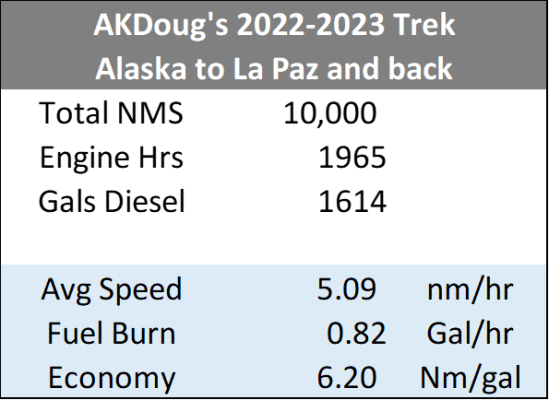Caballero II
Senior Member
- Joined
- Mar 12, 2017
- Messages
- 395
- Location
- USA
- Vessel Name
- Caballero II
- Vessel Make
- Grand Banks Classic 36
Pacific Coast Runs
What a delightful thread to read. I wish I could have made myself available in Santa Barbara to offer help or support. Simply messing about in boats. PM me if you're ever in the area again. Sorry I missed your passage.
Tim Vail
Caballero II
GB 36
Santa Barbara
I wound up bypassing Bodega in the dark, continued up past Fort Bragg after determining I had enough fuel to comfortably arrive in Eureka (into my reserve). The determining factor was that if I stopped for fuel I would miss the tide entering Humboldt Bay and there was no way I could make the time up enroute. My projection was to arrive near high slack on an incoming tide in the dark, which was accurate.
Having been in the Humboldt channel before I knew it was well marked and wide, at 05:00 AM I met no opposing traffic as I motored in through the heavy, wet, fog. It cleared off once inside the bay, and I successfully dodged the line of pot buoys on the approach to the channel as most were marked with reflectors and I was running my Rigid spot/flood light bar with no one to annoy with it.
It was an 80 hour run from Santa Barbara to Eureka, steady rpm’s at 2650, engine running like a well tuned sowing machine! I was 50 hours over on my oil change, but currently have 140 gallons of fresh fuel and new oil and filter changed out and ready for the next leg North to Newport. I also changed out the carbon filter on my r/o water maker (six months) and verified my last transmission oil change was in limits for maintenance.
I am not cooking tonight! Just took my second 3 hour nap of the day, the first when I came in too early for the fuel dock and anchored behind a channel marker in 26’ of water, the second in the Woodley Island Marina where I have an end tie. It looks like I am here until Tuesday, as there is a ten foot swell forecast for the bar until then, and good weather projected all the way North to Neah Bay.
Off to dinner, that’s the latest update!
Doug Nightingale
Melanie Rose
Willard PH 30
What a delightful thread to read. I wish I could have made myself available in Santa Barbara to offer help or support. Simply messing about in boats. PM me if you're ever in the area again. Sorry I missed your passage.
Tim Vail
Caballero II
GB 36
Santa Barbara

 So no difficulty with the Customs phone call to clear Bedwell?
So no difficulty with the Customs phone call to clear Bedwell?